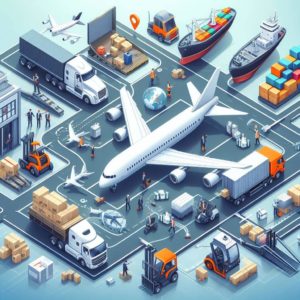[vc_row][vc_column offset=”vc_col-lg-9 vc_col-md-9″][vc_custom_heading source=”post_title” use_theme_fonts=”yes”][stm_post_details][vc_column_text css=”.vc_custom_1644316092913{margin-bottom: 30px !important;}”]Shipping Delays – Port Congestion
As seen and predicted by the economists, the shipping backups have not ended with the year 2021 and have continued to be a part of 2022. The global production and disruptions caused by the COVID-19 pandemic have left uncontrolled situations for shippers, ports, and consumers. These issues are largely coming due to the COVID-19 pandemic as consumers are unable to spend on traveling and dine-outs because of lockdowns, leading their interests to shift to apparel, technology, household items, and consumer electronics.
Tough all the 20 major ports of the world where huge volumes of global trade flows, are facing overwhelmed capacity crises. Particularly talking about Canada alone, the shift in consumer trend has caused an increase in imports as compared to exports during the pandemic. This in turn has caused serious congestion at the port. Container vessels are queueing up on the Vancouver port and have a minimum of two weeks’ time to get a chance to unload, take on new containers and go back to their routes. The empty containers are being piled up the port as well as private yards of transportation companies. The vessels which had to wait for weeks by the end of last year has increased to more than a month, due to the lack of berthing space. Yard density has been reported to be 113% at Prince Rupert in Canada.
The impact of high import volumes at the terminals can be seen on the trucking industry, railcar shortage and has slowed down the flow of containers from the port. The trucking capacity has reduced massively in the last few months. At the same, the chassis are in short supply which also is putting a great impact on the shipping delays.
It has been reported that a 12 to 15 percent increase in imports has been recorded on the Vancouver port. The import rate from Asia has risen monstrously and the supply chain has gone out of balance. Most of the containers have to return back empty while a lot of empty containers are occupying the space at the port as well as the inland terminals.
With the provided port congestion around the world comes many risks such as the risk of moisture damage to the cargoes. The containerized cargoes have not all been provided with protection against moisture which is a result of temperatures drops. Effective measures need to be taken suck as cargo moisture protection and considering insurance policies.
The analysts at sea congestion report that there is no sign of improvement in 2022 as of yet. Nonetheless, the authorities are working closely to slow down the sea transit for minimal vessel queueing to relieve the situation, but there is no quick fix to this. The country needs to expand the container terminal if they need a path out of this backlog and congestion crisis. The effort is real as it can be seen with the expanding operations of Ashcroft Terminal. It provides both inland translating and container storage facilities at a distance of 343 kilometers northeast of Vancouver. We hope to see its positive impact on the Asia-Canada trade and on the whole of this supply chain crisis.[/vc_column_text][stm_image_gallery images=”2898″][vc_column_text css=”.vc_custom_1644316101887{margin-bottom: 60px !important;}”][/vc_column_text][stm_post_bottom][stm_post_about_author][stm_post_comments][/vc_column][vc_column width=”1/4″ offset=”vc_hidden-sm vc_hidden-xs”][stm_sidebar sidebar=”272″][/vc_column][/vc_row]







